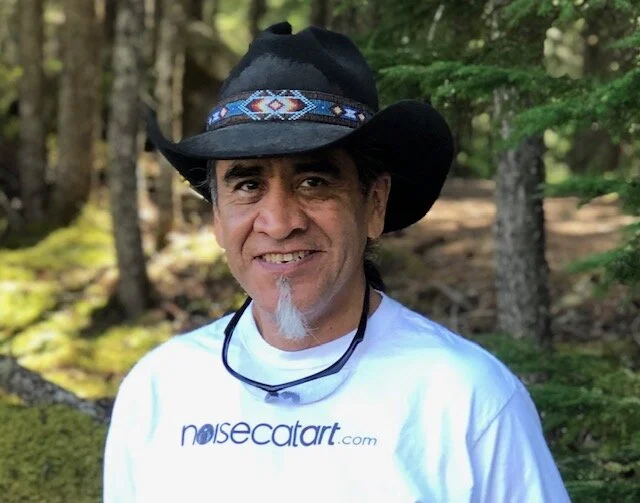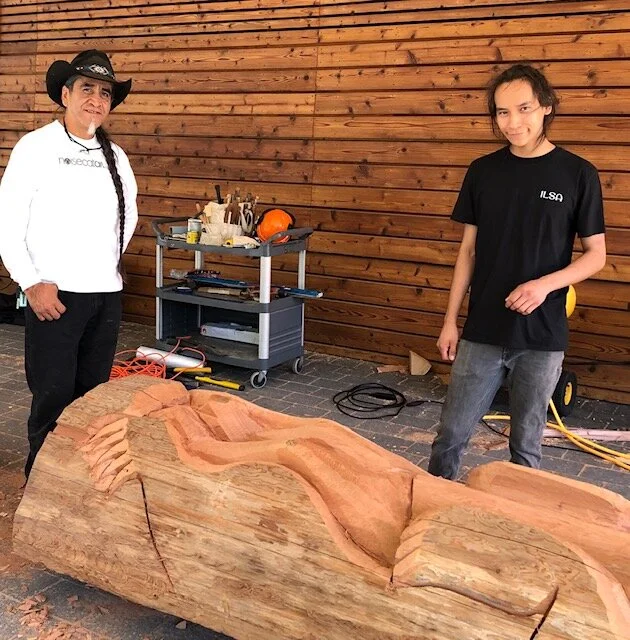With Sqātsza7 Tmicw – Father Land, artist Ed Archie NoiseCat comes home
The prolific Salish artist’s new exhibition marks a first for the Squamish Lil’wat Cultural Centre
Ed Archie NoiseCat graduated from Emily Carr University of Art and Design in 1986, then left B.C. to build his career. Photo by SLCC/Logan Swayze
Sqātsza7 Tmicw – Father Land is at the Squamish Lil’wat Cultural Centre until February 28, 2021.
GLASS, WOOD, STONE, silver, and steel: these are just some of the materials that Ed Archie NoiseCat fuses, carves, and transforms into works that merge his contemporary aesthetic with his Indigenous roots.
Having grown up in the Southern Cariboo with his mother’s people, the Canim Lake Band of the Shuswap Nation, he has built his career in the United States. Now, after more than three decades, the mixed-media artist is making a return to B.C. for the first time with a groundbreaking exhibition.
Sqātsza7 Tmicw – Father Land is currently running at the Squamish Lil’wat Cultural Centre in Whistler—marking the first time it has hosted a feature artist exhibition in its temporary gallery space.
The solo show features a breathtaking selection of pieces that illustrate the breadth of NoiseCat’s work.
Salmon King, 2016, Steel, hand-painted. 32”W x 48”H , $5,400. Photo by Ed Archie NoiseCat.
Bear Mother Moon Mask, 2018, Alder, Abalone & Bone, 11.6”W x 11.9”H x 3”D, $11,500. Photo by Wendy McEahern
Thunderwhorl, in kiln cast lead crystal, for instance, depicts the mythological creature Thunderbird resting atop Frog, the storyteller, underneath a rainbow in a spindle whorl design. The violet sphere sits on a metal stand of dual lightning bolts. According to Squamish Nation legend, Thunderbird roosts on top of Black Tusk Mountain and has the supernatural ability to create thunder and lightning to impose law and order. NoiseCat carved Bear Mother Moon Mask out of alder and adorned it with abalone and bone in honour of his daughter and her mother, the piece an homage to women’s strength. The Vanishing Run consists of six bronze-cast salmon swimming on a river of broken orange glass, which represents toxic mine tailing that was dumped into Colorado’s Animas River in 2015. With a steel base, the work was created at the Institute of American Indian Arts, where NoiseCat was the first artist in residence at its foundry.
NoiseCat’s pieces appear in private and public collections, including that of the National Museum of the American Indian in Washington, D.C. The 40-foot banner he designed and that flew from the Iron Workers Memorial Bridge in 2018 as part of an aerial blockade to protest the Trans Mountain Expansion Pipeline Project is now housed at the Museum of Vancouver (MOV).
Getting to this point—as a masterful and prolific multidisciplinary craftsperson—however, required going away.
NoiseCat grew up playing hockey and baseball and riding broncos in Canim Lake near 100 Mile House. (The Shuswap Nation is part of the Interior Salish People, who cover the area from the coast to the Cariboo region, from Northern B.C. to Washington State.)
He had planned on becoming a phys ed teacher, but an administrative error related to university transfer credits serendipitously landed him in the fine arts program at UBC. His drawing skills were obvious. He went on to specialize in stone lithography at Emily Carr University of Art and Design, graduating in 1986. Immediately thereafter, he was hired as a fine-art printmaker by Tyler Graphics in New York.
In the Wake of the Whale, 2019, Limited Edition Fused Glass, 19.25”W x 23.75”H x 0.3”D, $5,500. Photo by Wendy McEahern
Salmon Run Bracelet, Cast Sterling Silver, 15 links, length is 7.25 “L, 1.75” wide, $3500. Photo by Hilary Wallace Brelsford
“I finished art school and moved away,” NoiseCat says in an interview at the SLCC. “There was nothing here for me. I grew up in the ’70s on a little reservation and went to public school in 4th grade. I was in Indian day school until then. Most of the carvers you would run into here were trained by other carvers, but there was no one that I could study under or learn from where I grew up. Our tiny little reserves were decimated by the Roman Catholic church.
“I came out of a pretty deep cultural divide,” he says. “when I look back, it’s actually pretty extraordinary I got off that little reserve and got out and did what I did because the opportunities are very, very small, if you can even find one. I had to find some success—a reason, a meaning for being in the world—rather than just sitting on a reservation doing nothing. That was the other choice.”
NoiseCat, who has two grown children and wears his waist-long hair in a thick braid or two, is now based in Bremerton, Washington. Upon leaving Canada for the U.S., he took back his traditional last name, which belonged to his grandmother prior to her marriage. During his childhood in Canim Lake near 100 Mile House, he was known only as Ed Archie. “That was the name given to us by missionaries when they stole our souls,” NoiseCat says. “I wanted to relegate that name to a secondary position and reclaim my original name.”
As he travelled throughout the U.S., NoiseCat immersed himself in the contemporary art world, acquiring new skills, techniques, and tools along the way. He has taught sculpture at the Institute of American Indian Arts and is an instructor at the Pratt Fine Arts Center in Seattle. Among his monumental works is a portrait mask of Taoyateduta, or Chief Little Crow, in Minnehaha Park in Minneapolis, Minnesota. As part of his residency at SLCC, he is teaching cultural ambassador Q̓awām (Wolf) Redmond Andrews, who’s of the Lil’wat Nation, how to carve. Together, they’re working on a 20-foot pole of red and yellow cedar, which, when complete, will be raised and featured in the cultural centre’s Great Hall.
Curated by NoiseCat in collaboration with SLCC’s director of culture, Kimberly Stanger, and curator Mixalhitsa7 Alison Pascal, Sqātsza7 Tmicw – Father Land is a literal homecoming: NoiseCat’s father comes from the Lil’wat Nation.
“I went about finding my direction by going out into the world,” NoiseCat says. “I’ve kind of come full circle back to my father’s territory. I’m bringing the contemporary art world here.”
NoiseCat didn’t always have permission to use his traditional family name. Photo by Gail Johnson
Ed Archie NoiseCat (left) spent time mentoring Lil’Wat Nation member Redmond Andrews, a cultural ambassador at the Squamish Lil’wat Cultural Centre, as part of his time in Whistler recently. Photo by Gail Johnson




















